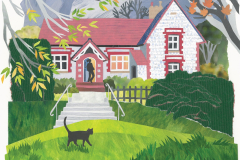This gallery of prints is for viewing only. They are past commissions, sold out editions and images from the Lewes Printmakers’ group projects. I hope you enjoy looking through them and that they give you a further flavour of the sort of work I do.
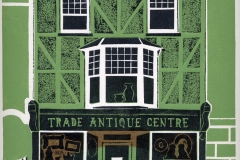
Trade Antique Centre
Trade Antique Centre Collagraph Along with Baxter’s Printing Works, I also chose this antique shop as a subject for ‘High Street’, the Lewes Printmakers’ very first group collaboration. I love the way the building sits on the steep hill and had great fun cutting out and arranging all the antiques.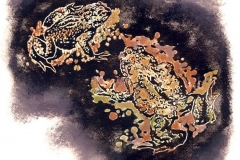
Common Toads
Etched lino From the Lewes Printmakers’ sixth book ‘Railway Land’. Though now a nature reserve and public open space, on part of this land where woodland thrives once stood ‘Leighside’, a grand Victorian house. The fine grounds around it contained a lake and specimen trees. Today the lake is no more than a pond but it is of great value to wildlife including Common Toads which breed there. I created some of the textures in the print by first ‘etching’ the lino block with old fashioned cooker cleaner.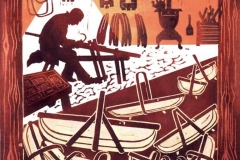
The Truggery
Linocut with hand colouring Designed for The Truggery at Coopers Croft, Herstmonceux. Special Sussex baskets known as trugs have been made here since 1899 and are still produced using the same tools and traditional methods. My image gives a glimpse inside the workshop while a range of trugs for different uses are displayed ready to be sold in the foreground.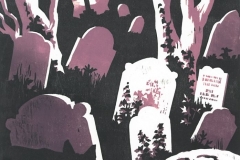
The spaces in between
Woodcut My contribution to the Lewes Printmakers’ ninth book ‘The Spaces in Between’ which celebrates the wild spaces, unexpected vistas and ancient twittens of Lewes. Here the churchyard of St John sub Castro is a green space for wildlife to thrive and a place for people to relax and think. Groups of disorderly gravestones, jumbled and overgrown, provide hide-outs fit for the fox.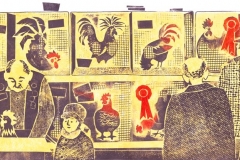
Prizewinners
Collagraph and stencil. I worked for several years at Middle Farm in Firle which had an extensive collection of poultry breeds. Selected birds were often shown at poultry shows after meticulous clipping, cleaning and blow drying. ‘Prizewinners’ was the result of a works outing to ‘The Federation’ in Staffordshire. Sadly it cannot convey the smell and incredible noise created by the thousands of hopeful fowl.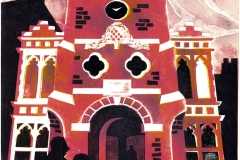
The Market Tower
Collagraph The Market Tower, Lewes which dates from 1792. This image comes from the Lewes Printmakers’ fourth book ‘Tom Paine in Lewes’.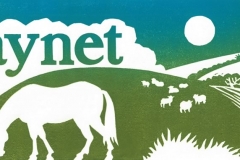
Haynet logo
Linocut Logo for Haynet www.hay-net.co.uk. The leading network for blogging from the stables, farms and fields.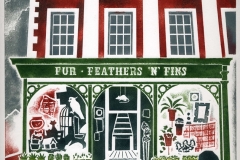
Fur, Feathers ‘n‘ Fins
Collagraph From the Lewes Printmakers’ (formerly Paddock Printmakers) second group project ‘Cliffe’. This focused on buildings around Lewes’s historic Cliffe High Street. As I am drawn to anything animally, I picked the pet shop with the white rodent sign above the door.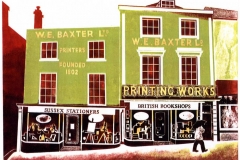
Baxter’s Printing Works
Collagraph From the Lewes Printmakers’ (then known as Paddock Printmakers) very first group collaboration ‘High Street’. We created a concertina style book published in 2004 which featured a selection of buildings on and around the historic high street in Lewes. I particularly enjoyed the challenge of all the lettering on Baxter’s Printing Works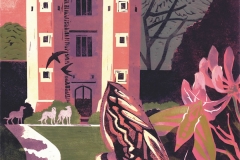
Hawkmoths and the Gatehouse
Linocut A private commission and portrait of an intriguing historic building. Here the delicately pattered Privet and Elephant Hawkmoths feed on honeysuckle while swifts catch insects in the dusky evening light.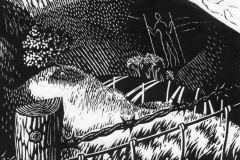
The Long Man of Wilmington
Linocut printed on imitation Japanese paper, edition of 50. Image size: w17.5cm x h18cm Mounted size: w29.6cm x h31cm A much loved chalk hill figure on the South Downs who has been depicted by scores of artists down the years. This is my portrait of him.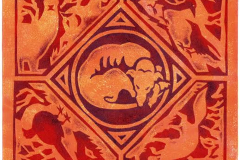
In her dreams
Relief print from cut card printed on Fabriano Artistico paper, edition of 14. Image size: w21.3cm x h21.8cm Mounted size: w34.3cm x h36.5cm The simple beauty of Medieval tiles led to this image. My ‘tile’ shows a lurcher sleeping contentedly in the centre surrounded by creatures that she encounters day to day. The materials used to make the blocks were readily available and inexpensive – just an old cereal packet carefully cut with a scalpel, glued down and varnished.